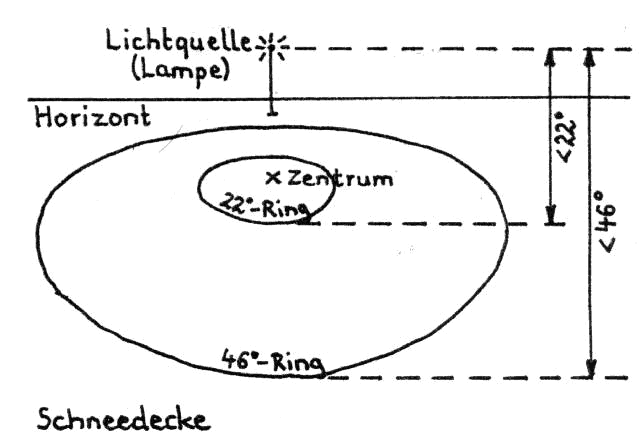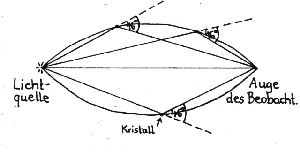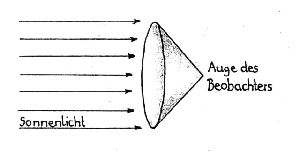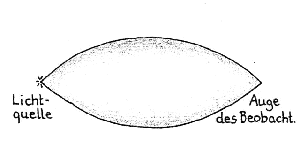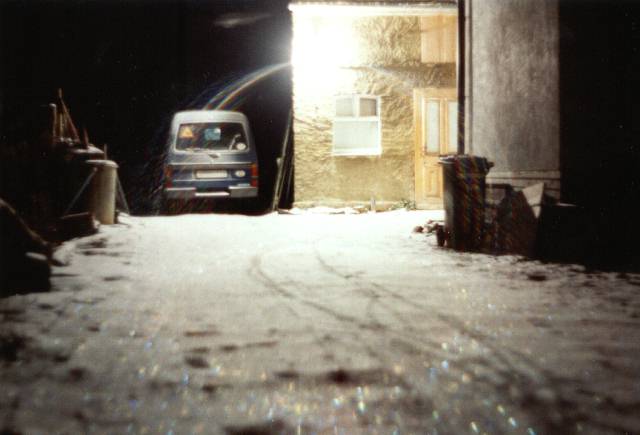The present work deals with halo phenomena (light refraction phenomena in hexagonal ice crystals) that occur on the snow cover or in frost and are caused by terrestrial light sources (e.g., street lamps).
In the scientific community, similar phenomena are known, but they are caused by the sun or moon. Due to the radial path of light from a terrestrial light source, certain deviations occur compared to these phenomena.
Snow cover halos below terrestrial light sources represent a previously unconsidered phenomenon, which has not been mentioned even in specialized literature.
This work documents the observation of this phenomenon and explains it in a model-based manner. Furthermore, the mathematical methods are presented with which such snow cover halos can be simulated. The implementation of the formulas was carried out with a computer program that allows simulations from various perspectives.
Observation and Explanation of Snow Cover Halos
1. Thematic Delimitation
Before the snow cover halos are discussed in more detail in this work, this rare natural phenomenon should first be classified into the diverse group of atmospheric optics. This provides the opportunity to gain a better understanding of the existence of such natural phenomena.
The group of atmospheric optics primarily includes halos, coronas, rainbows, and halo phenomena, which probably everyone has seen before. Among all phenomena in this group, halo phenomena are the most common. These are optical light phenomena in the troposphere, whose formation is due to light refraction and reflection on hexagonal ice crystals (see figure).
The group of atmospheric optics primarily includes halos, coronas, rainbows, and halo phenomena, which probably everyone has seen before. Among all phenomena in this group, halo phenomena are the most common. These are optical light phenomena in the troposphere, whose formation is due to light refraction and reflection on hexagonal ice crystals (see figure).
With a refractive index of n = 1.310 for ice, light is generally deflected by 22° or 46° when passing through the hexagonal ice crystals. The light also splits into its spectral colors. If these crystals are randomly oriented when falling through the atmosphere, the 22° ring and 46° ring are formed, with the red light component on the inner side of the rings. The sharply defined inner edges of the rings correspond to the minimum deviation angles of 22° and 46°. Outwards, the light concentration decreases evenly (in the right drawing realized by rotation of the crystal).
| Sonne | Mond | Lampe | ||
| Ganzjahreshalos | (1) Cirrenhalos | 157 d | 38 d | - |
| Ganzjahreshalos | (2) Eisschirmhalos | 12 d | 2 d | - |
| Ganzjahreshalos | (3) Fallstreifenhalos | 8 d | 2 d | - |
| Winterhalos | (4) Eisnebelhalos | 1 d | 0 d | 0 d |
| Winterhalos | (5) Polarschneehalos | 2 d | 0 d | 0 d |
| Winterhalos | (6) Schneedeckenhalos | 2 d | 0 d | 10 d |
| Winterhalos | (7) Reifkristallhalos | 8 d | 0 d | 1 d |
| Gesamtzahl aller Halotage | 173 d | 41 d | 11 d |
(1) in high clouds (Ci / Cc / Cs)
(2) in anvil clouds of shower / thunderstorm clouds (Cb cap)
(3) in virga from middle / low clouds (Ac vir / Sc vir / Cu vir)
(4) in fog / remaining low stratus, in layers with suspended ice crystals in clear sky
(5) in falling ice crystals as frozen precipitation (snow, snow grains, ice needles, diamond dust)
(6) in deposited ice crystals on the ground / on snow surface
(7) in frost crystals on grasses / shrubs / trees, in floating frost crystals
(2) in anvil clouds of shower / thunderstorm clouds (Cb cap)
(3) in virga from middle / low clouds (Ac vir / Sc vir / Cu vir)
(4) in fog / remaining low stratus, in layers with suspended ice crystals in clear sky
(5) in falling ice crystals as frozen precipitation (snow, snow grains, ice needles, diamond dust)
(6) in deposited ice crystals on the ground / on snow surface
(7) in frost crystals on grasses / shrubs / trees, in floating frost crystals
2. Observation of snow cover halos at the sun and below terrestrial light sources
The following observation report was already published with a theoretical consideration of snow cover halos below earthly light sources in the "Mitteilungen des AKM" (MM No. 2 / 1997, pp. 30-34). It appears here in a revised and partially shortened version. Regarding the current weather conditions, it should be noted that a 24-day continuous frost period from 20.12.1996 to 12.01.1997 with extremely low temperatures (down to -22°C!) was the cause of the occurrence of numerous winter halos.
Snow Cover Halos at the Sun
On the evening of 29.12.1996, an occlusion brought light snow drizzle (no snowflakes) to the Klettwitz area. The air temperature dropped from -10°C to -13.6°C by the next morning. Measurements on the following day showed that the new snow layer was only 2 mm, which settled on an already existing snow cover 2 to 3 cm thick. Due to the low temperatures, I was continually on the lookout for snow cover halos—as I had been in recent days—apparently with success this morning.
On flat areas of the snow cover, a slight arc-shaped glittering could be seen at a distance of 22° under the sun. The phenomenon was especially noticeable with movement, as the glitter arc "moved" with a change in position. When attempting to photograph this phenomenon on a snow-covered ice surface (a large flat snow cover), I also discovered a regular arc-shaped glitter at a distance of 46° under the sun, although somewhat weaker than the 22° ring. The lower edge of the 46° ring appeared about 2 m in front of my feet! The individual crystals on the snow surface, which caused both phenomena, glittered in all spectral colors. Both rings remained visible throughout the day.
Initially, I suspected that the halos were due to crystalline hoarfrost plates (alignment of columns) as they had only formed the previous night. But upon closer examination of the new snow, I eventually found a distinctly hexagonal ice plate (diameter: 0.5 mm). The new snow was certainly the cause of the snow cover halos.
The drawing shows all observed halo phenomena at the peak on 30.12.1996. From 10:23 to 10:33, in addition to the two snow cover rings, 4 more halo forms were observed in cirrus clouds: the 22° parhelia, a fragment of the 22° ring with upper tangent arc, and the circumzenithal arc. Such a combination of halo phenomena in the sky and simultaneously on the snow is extremely rare.
Snow cover halos below terrestrial light sources
That same evening, I came up with the idea to observe the snow cover under the light of a streetlamp. Indeed, on the flat snow surface of the frozen garden pond, an arc-shaped glinting of the snow crystals about 20° below the lamp could also be seen. However, the observation was only possible in a crouched position (eye < 0.5m above the ground) due to the low light intensity of the streetlamp about 50 m away. Interestingly, the radius of the 22° ring became smaller as one approached the light source, and the phenomenon was indistinguishable from the usual glittering of the snow at a distance of about 30 m.
This process could only be attributed to the radial light path of the streetlamp. By simply constructing the light path with a refraction angle of 22° in the snow, the process was confirmed, which depends on the observer's and lamp's height and their distance from each other. In the sketch for the line observer - lamp, I obtained a second theoretically present ring radius, which was smaller than that of the observed ring. It also became apparent that both radii would continue to converge towards the lamp until they suddenly disappeared on contact.
This interesting phenomenon was to remain unresolved for the time being, as no snow cover halos appeared in the following days - at least until 4.01.1997.
On the evening of the 4th of January, a new snow cover about 4 mm thick formed at -7°C from snow grains. The grains consisted of an unusual combination of snow stars, ice needles (partly graupel), ice crumbs, and individual ice grains.
At the same time, I made a surprising discovery. In the light of our courtyard lamp, a 22° ring appeared on the snow surface, completely beneath the lamp, which changed its position and size as it moved. I now realized that the second theoretically determined ring radius was nothing else than the top edge of the complete ring. The inner edge was clearly defined (due to minimal deviation), while the glittering of the snow crystals gradually decreased outward ("fringiness" of the ring). Hardly any glittering was observed within the ring. The lower edge of the ring had a distance of about 20° from the light source when far from the lamp, which decreased as one approached it. Not only did this distance reduce, but the entire ring contracted until it was just a spot (progression see fig.). As I further approached the earthly light source, the previously invisible 46° ring appeared, with its center now the spot of the remaining 22° ring. Eventually, the spot and the large ring shrank as the small ring did previously, to its center, until it too was just a spot, which eventually disappeared.
Deformation of the Snow Blanket Halos Approaching the Earth's Light Source (5. 1. 1997)
The original radii of both mentioned rings could be determined from a greater distance by freehand measurement, since the distance from the lower edge of a ring to the light source approaches the refraction angle of 22° or 46°. However, the full value can never be reached because the light rays of a lamp only run approximately parallel even at a great distance. Since the ring size constantly changed depending on the location and height of the observer's eye, I saw no reason to determine the exact extent of the supposed circle. In the process, I missed an important appearance that I only noticed later in the photos - the ring had an ellipse-like shape. By measuring the ratio of height to width of several photographed rings, it was shown that they were about 2 to 2.5 times as wide as they were high. Later simulations also revealed that the appearance can be very variable in its form.
When diamond dust fell from stratus clouds at midday on January 5th (at -7°C and 98% relative humidity), it settled evenly on the ground. The rings were extraordinarily bright and clear the following night. On January 6th, about 1 cm of fresh snow (only snowflakes) fell on the halo-producing ice crystals, which caused a dimming of brightness for the coming nights. Nevertheless, both rings could be recognized. It wasn't until January 10th and 11th that it drizzled again. As a result, the snow cover halos became clearer and above all more colorful. When the sun appeared for the first time on January 12th, it was also surrounded by both rings (at -0.2°C!). With its appearance, the persistent frost ended the next day and the snow cover thawed on the surface, resulting in the disappearance of the snow cover halos.
The reason for the longevity of the phenomena is due to the weather situation. From January 4th to January 12th, a continuously present layer of high fog prevented the sun from affecting the snow cover. Simultaneously, the clouds repeatedly provided a supply of ice crystals. Whether it was snow drizzle or even diamond dust, the fresh snow positively affected the brightness of the usually weakening halos. It is also interesting that the phenomenon was even visible on areas that were often walked on or driven on! The snow cover halos were not only observed under our yard lights, but also under numerous street lamps and even under the headlights of moving cars.
After the first few days, I had the feeling that this is not such a rare phenomenon. However, I could find no information about snow cover halos under terrestrial light sources, which prompted me to investigate the cause of this phenomenon myself (-> 3. Explanation of the principle of formation).
Halo literature is unfortunately sparse, and in all known works, there are not the slightest hints about the existence of this special phenomenon. Only in Minnaert ("Light and Color in Nature") is the observation of a 22° halo at a lamp described (as a spindle-shaped three-dimensional phenomenon). The possibility of this phenomenon occurring on the snow surface was not considered. It is therefore assumed that this special form of snow cover halos has not been observed or consciously perceived by anyone since.
Snow cover halos can also occur in frost crystals, and more frequently than previously assumed! Since the discovery of snow cover halos under terrestrial light sources (Jan. - Dec. 1997), 9 frost halo observations at the sun and 12 observations under terrestrial light sources have been made in Klettwitz. Ultimately, it can already be said that almost every frost phenomenon can produce a 22° ring. The corresponding frost crystals often form during radiation frost and calm wind conditions on a clear night. These conditions are mainly met in the months of March, April, October, and November, where most frost halos have been recorded.
Primarily, the occurrence of this phenomenon, whether in frost or snow, proves the presence of regular hexagonal ice crystals on the ground. What remains unclear is why only the 22° ring forms in frost and not the 46° ring. Presumably, the hexagonal frost crystals do not have smooth basal surfaces, which are necessary for the formation of the 46° ring. To prove this, the crystals would need to be examined under a microscope.
3. Explanation of the Principle of Origin
In the following section, the cause of the formation of snow cover halos below earthly light sources will be explained before this phenomenon is considered from a mathematical perspective in the second part of this work. This also requires a bit of spatial imagination.
The 46° ring phenomenon was chosen as an example for explanation. Since the halo can appear in the immediate vicinity of the observer in winter, polar snow is initially considered responsible for the creation of the phenomenon. That is, the observer is surrounded by falling hexagonal ice crystals that occupy the entire space around them. Naturally, there is also a light source illuminating the mentioned space. The result is that light rays are refracted in each ice crystal (in this example by 46°). However, only that refracted light reaches the observer's eye that is refracted in crystals positioned at certain spots. Hence, all halo-causing ice crystals have a specific three-dimensional arrangement, even though, for example, a 46° ring in the sun is perceived by the observer as a two-dimensional structure. The spatial arrangement mentioned here is to be regarded as the outer shell of geometric bodies, which in their shape form the key to explaining the phenomena.
The 46° ring phenomenon was chosen as an example for explanation. Since the halo can appear in the immediate vicinity of the observer in winter, polar snow is initially considered responsible for the creation of the phenomenon. That is, the observer is surrounded by falling hexagonal ice crystals that occupy the entire space around them. Naturally, there is also a light source illuminating the mentioned space. The result is that light rays are refracted in each ice crystal (in this example by 46°). However, only that refracted light reaches the observer's eye that is refracted in crystals positioned at certain spots. Hence, all halo-causing ice crystals have a specific three-dimensional arrangement, even though, for example, a 46° ring in the sun is perceived by the observer as a two-dimensional structure. The spatial arrangement mentioned here is to be regarded as the outer shell of geometric bodies, which in their shape form the key to explaining the phenomena.
Arrangement of ice crystals, which, when diamond dust (polar snow) falls and sunshine (parallel light rays) occurs, create a 46° halo
The halo-causing crystals, which produce a ring of light for the observer's eye, are arranged in a conical shape. (The outer shell of the cone corresponds to this crystal surface!)
Attempt to Explain
On a flat snow cover, the ice crystals are distributed two-dimensionally, so that only limited parts of the actual halo phenomenon become visible. The observer then only sees the intersection curves of the geometric bodies on the snow surface, which are referred to as snow cover halos. Imagine the spindle-shaped body of a lamp halo dips into the snow cover, creating the halo ring visible to the observer on the snow surface at its outer edge. While the conic sections (hyperbolas) appear clearly as circular segments at the sun, the intersection lines of the spindle bodies are not defined in their geometric form. When the distance between the observer and the lamp is not too great, the intersection line is an ellipse-like formation that extends lengthwise along the line observer - lamp. The observer sees this intersection line due to perspective as a transverse, ellipse-like formation, which in its form of appearance is referred to as a snow cover halo below a terrestrial light source.
As the aforementioned spindle body shrinks in its spatial extent as the observer approaches the light source (because it maintains its base shape adjusted to the refraction angle), it also automatically detaches from the snow cover. From the observer’s point of view, this process can be observed as the increasing shrinking of the snow cover ring. When the spindle body only touches the snow surface, the halo is only recognizable as a spot. Further approach to the lamp causes the spindle body to completely leave the area of the snow cover, so the halo phenomenon is no longer visible.
Expanding the spindle body model into space also allows halos at extraterrestrial light objects (assumed as point light sources), such as the sun, to be defined. Due to the enormous distance from the observer to the light source, only the very tip of the spindle body (which is directly at the observer's eye during a lamp halo) is responsible for the halo rings in the atmosphere. This tip comes very close to the shape of a cone, which is known to explain the formation of solar halos. In essence, the deviation from the cone cannot be proven on Earth.
Contraction process of a 46° ring on the snow cover when approaching the light source
4. Construction model for representing all ring-shaped light refraction phenomena
The spindle body model is defined by a rotating circular segment, which obtains a specific curvature depending on the angle of refraction $\alpha$ in the ice crystals. In order to construct the circular segment, the position of the circle center M must first be determined, which bounds the circular segment with the angle 2$\alpha$, corresponding to the opening angle of the spindle body. In this way, all annular refraction phenomena can be modelled, including the rainbow ($\alpha$ = 138° or 129°).
B - Eye of the observer
L - Light source (lamp / streetlight)
M - Center for constructing the circle segment
O - Upper edge of the ring
U - Lower edge of the ring
Z - Ring center (converges here)
$\gamma$ - Perspective ring height known values: e - Distance from observer to lamp
hB - Height of the observer's eye
hL - Height of the light source
$\alpha$ - Refraction angle of the light in the ice crystals
L - Light source (lamp / streetlight)
M - Center for constructing the circle segment
O - Upper edge of the ring
U - Lower edge of the ring
Z - Ring center (converges here)
$\gamma$ - Perspective ring height known values: e - Distance from observer to lamp
hB - Height of the observer's eye
hL - Height of the light source
$\alpha$ - Refraction angle of the light in the ice crystals
Photographs and Computer Simulations
22°- Snow cover halo at a terrestrial light source. Lamp height = 2.7 m, observer height = 0.6 m, distance = 17.6 m
Recording: 5.01.1997, 21.53 CET, -8.5°C
Sources
Lionheart, Richard: Halo phenomena on falling ice crystals, in crystals on the snow surface, and on the snow cover under terrestrial light sources.
In: Communications of the Meteor Circles, Volume 22 (1997), No.2, p. 30 ff Minnaert, Marcel: Light and Color in Nature.
Basel: Birkhäuser Verlag, 1992, pp. 284 / 286 Schröder, Gottfried: Technical Photography.
Fundamentals and Applications in Technology and Science.
Würzburg: Vogel Verlag, 1981, p. 74 f Collective of Authors: Consult: Nature. Revised and Extended Edition.
Leipzig: VEB Bibliographical Institute, 1956. pp. 436 ff Collective of Authors: Algebra and Geometry for Engineering and Technical Schools. 3rd Edition.
Leipzig: Technical Book Publishing House, 1967, p. 421 Bartsch, Hans-Jochen: Pocketbook of Mathematical Formulas. 16th Edition.
Leipzig-Cologne: Technical Book Publishing House, 1994, pp. 205 ff
In: Communications of the Meteor Circles, Volume 22 (1997), No.2, p. 30 ff Minnaert, Marcel: Light and Color in Nature.
Basel: Birkhäuser Verlag, 1992, pp. 284 / 286 Schröder, Gottfried: Technical Photography.
Fundamentals and Applications in Technology and Science.
Würzburg: Vogel Verlag, 1981, p. 74 f Collective of Authors: Consult: Nature. Revised and Extended Edition.
Leipzig: VEB Bibliographical Institute, 1956. pp. 436 ff Collective of Authors: Algebra and Geometry for Engineering and Technical Schools. 3rd Edition.
Leipzig: Technical Book Publishing House, 1967, p. 421 Bartsch, Hans-Jochen: Pocketbook of Mathematical Formulas. 16th Edition.
Leipzig-Cologne: Technical Book Publishing House, 1994, pp. 205 ff
by Richard the Lionheart and Alexander Haußmann




